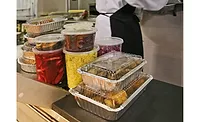Seven ways to ensure the safety of packaged foods

Food safety regulations across the globe exist to ensure that only safe, uncontaminated packaged foods are available for purchase. They also regulate the accurate weight and truthful labeling of packaged foods to prevent consumers being misled. The following are practical ways that food manufacturers and processors can adopt to conform to those regulations and to deliver the consumer benefits the regulations support.
1. Detect and remove all contaminants
Requirement: All packaged food must be free from foreign contaminants. Most regulations give manufacturers the flexibility to adopt the most suitable inspection systems.
Solution: Integrate product inspection technology, either metal detection or X-ray systems depending upon the potential types of foreign bodies, into manufacturing lines to identify and reject contaminated products in real time.
2. Confirm all product safety markings
Requirement: No sub-standard food must be allowed to enter the marketplace, such as packaged products that suggest diminished quality and freshness by displaying expired “use by” and “best before” dates.
Solution: Machine vision inspection systems can perform a range of in-line quality assurance checks, including the presence and readability of specific dates and 2-D and 3-D codes.
3. Confirm Advertised Weight
Requirement: Net content laws and regulations differ around the globe: they range from requiring that “the average weight of the product cannot be less than the labelled weight” to that it be “within pre-defined tolerances.”
Solution: In-line checkweighing technology conducts 100% inspection of the highest accuracy and at top production speeds, ensuring that the weight of each packaged product matches the weight shown on its label. Product weights falling outside set parameters are rejected.
4. Verify Label Accuracy
Requirement: All packaged products must clearly communicate product information in accordance with the labelling laws of each country where they will be sold. In general, these laws require that each label display the net quantity of product, plus ingredient and allergen information. Some countries have additional mandatory requirements.
Solution: Innovative machine vision inspection technology inspects the content of all labels, according to pre-programmed criteria, at production line speeds, and rejects those that do not conform before they can reach the marketplace. They also confirm label positioning, readability and ensure that a fold or wrinkle does not cover vital information
5. Confirm that the Product is “As Advertised”
Requirement: All products must be as advertised and not mislead the consumer. For example, manufacturers must ensure that a multipack contains the correct number of units, and that no items are broken, and that a meal kit contains all the necessary items for use.
Solution: X-ray inspection technology simultaneously accounts for the items in a multipack or kit, and confirms their integrity.
6. Be Prepared to Prove Due Diligence
Requirement: In the event of a regulatory agency visit or a product recall, authorities require packaged food manufacturers to prove that they have exercised due diligence in their manufacturing and packaging processes.
Solution: Utilize today’s advanced inline inspection systems that monitor and record all quality assurance activities in real time, using advanced data management software to seamlessly integrate all inspection devices to streamline operations and collect production and inspection data. In the event of an inspection or recall, that data is immediately available to share with regulators. It is also available to support the manufacturer’s Continuous Improvement activities.
7. Ensure consistent equipment performance
Requirement: Consistent and accurate data is the key to compliance, and manufacturers’ food safety plans must include verification activities. To achieve this, manufacturers must regularly verify the performance of their food safety equipment to ensure they are functioning correctly.
Solution: Investing in a service contract with the equipment manufacturer ensures that preventive maintenance and performance verification support will provide reassurance that product inspection equipment continues to operate as it should and that it meets regulatory approval.
Integrating these seven solutions into a robust food safety management plan will enable packaged food manufacturers to comply with food safety regulations, and also to protect their brand image from the damage that can come from a recall. But, in addition, being able to demonstrate to authorities that the public is fully protected from non-conforming packaged food also often enables brand owners to enter lucrative new markets with a solid reputation for producing reliably safe foods.
About METTLER TOLEDO Product Inspection
METTLER TOLEDO Product Inspection is a division of METTLER TOLEDO, Inc., a global supplier of precision instruments with sales and service locations in over 39 countries. The division—consisting of Safeline, Hi-Speed, CI-Vision, and PCE—is the world’s leading supplier of metal detectors, X-ray inspection systems, in-line checkweighers, machine vision systems, and serialization/Track & Trace solutions. These systems are used in many industries, including food, beverage, pharmaceutical, nutraceutical, personal care, plastics and chemicals, to continuously ensure the quality of their products and improve the efficiency of their manufacturing and packaging processes.
Looking for quick answers on food safety topics?
Try Ask FSM, our new smart AI search tool.
Ask FSM →







